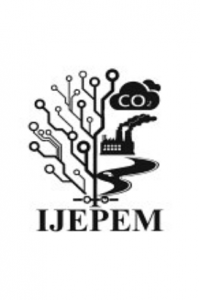Impact of the Global Climate Change on Land Degradation in Egypt
Impact of the Global Climate Change on Land Degradation in Egypt
Climate change, land degradation, Desertification,
___
- [1] Cumhur, A. and Malcolm, S. (2008). The Effects of Global Climate Change on Agriculture. American-Eurasian J. Agric. & Environ. Sci., 3 (5): 672
- [2] IPCC, (2001a). Climate Change 2001: The Scientific Basis. Houghton, J.T., Ding, Y., Griggs, D.J., Noguer, M., van der Linden, P.J., Dai, X., Maskell, K. and Johnson, C.A. (Eds.) Cambridge University Press, UK, 881 pp.
- [3] Salinger, M., Stigter, C. and Das,H. (2000). Agrometeorological adaptation strategies to increasing climate variability and climate change. Agricultural and Forest Meteorology, 103 (1-2):167
- [4] Mike, H. (2003). The conference Global Climate Change and Biodiversity, University of East Anglia, Norwich, UK
- [5] Mohamed, T. and Samir,S. (2005). Greenhouse Gases Inventory and Sea Level Rise An Egyptian Perspective. Environ Sci & Pollut Res., 12 (2):114
- [6] Daniel, J. and Darrell, A. (2009). Effect of climate change on air quality. Atmospheric Environment, 43 (1):51
- [7] Maria, K. (2009). Global warming and livestock husbandry in Kenya: Impacts and adaptations. Ecological Economics, 68 (7): 1915
- [8] Masoud, A. and Koike, K. (2006). Arid land salinization detected by remotely-sensed landcover changes : A case study in the Siwa region, Egypt. Journal of arid environments. 66 (1):151
- [9] Benoit, L., Meisner, D., and Wheeler, D. (2007). The Impact of Sea Level Rise on Developing Countries: A Comparative Analysis. SSRN Social Science Research Network, World Bank Policy Research Working Paper No. 4136
- [10] Robert, J. (2002). Analysis of global impacts of sea-level rise: a case study of flooding Physics and Chemistry of the Earth, Parts A/B/C, 27 (32-34):1455
- [11] Mohamed, A.T. (2008), Eastern Nile Planning Model, Integration with IDEN Projects To Deal with Climate Change Uncertainty and Flooding Risk Nile Basin Water Engineering Scientific Magazine, 1, 86-93
- [12] Mahmoud, M.,.El Banna, O. And Frihy, E (2009). Human-induced changes in the geomorphology of the northeastern coast of the Nile delta, Egypt. Geomorphology, 107(1-2):72
- [13] Sestini, G. (2000).UNEP/GRID Geneva; Florence; Remote Sensing Center, Cairo; DIERCKE, Weltwirtschaftsatlas. http://www.grida.no/publications/vg/climate/page/3087.aspx
- [14] El-Raey. M.., Dewidar, K..and El-Hattab, M.(1999). Adaptation to the Impacts of Sea Level Rise in Egypt. Mitigation and Adaptation Strategies for Global Change, 4 (3-4): 343.
- [15] Zhao, H., Rui, Z., Tong, H. and Xue, Y. (2006). Effect land degradation in properties soils China. Effects of desertification on soil and crop growth properties in Horqin sandy cropland of Inner Mongolia, north China. Soil and Tillage Research, 87 (2):171
- [16] Zhao, H., Hui, Y., Rui, Z., Zhong, Y., Oiang, Y., Yu-Hui He, Rui-Lian Zhou, Yong-Zhong Su, Yu-Qiang Li, Sam Drake.and Sam, D. (2009). Impact the desertification on fertility China. Effects of desertification on soil organic C and N content in sandy farmland and grassland of Inner Mongolia. CATENA, 77 (3):187
- [17] Rodomiro, O., Kenneth, D., Bram G., Raj G., Subbarao, G. and Matthew, R. (2008). Climate change: Can wheat beat the heat? Climate change: Can wheat beat the heat? Agriculture, Ecosystems & Environment, 126 (1-2):46
- [18] Saleh, S., Medany, M., El-Behiry, U. and Abu- Hadid, A. (2008). Effect of air temperature under climate change conditions on potato productivity in Egypt. Ninth International Conference on Dryland Development Sustainable Development in Drylands – Meeting the Challenge of Global Climate Change, Alexandria, Egypt
- [19] Farag, A., Abul-soud, A. and Medany, M. (2008). Impact of climate changes on wheat production under Egyptian conditions. Ninth International Conference on Dryland Development Sustainable Development in Drylands – Meeting the Challenge of Global Climate Change, Alexandria, Egypt.
- [20] Assem , M., Bahaa, M., Salah , M. and Medany, M. (2008). Economics of some vegetable crops under different climate zones in Egypt. Ninth International Conference on Dryland Development Sustainable Development in Drylands – Meeting the Challenge of Global Climate Change, Alexandria, Egypt.
- [21] El-Marsafawy, S. (2006). Impact of climate change on sunflower crop production in Egypt. The 2nd International Conf. on Water Resources & Arid Environment .Riyadh, Saudi Arabia
- [22] Sivakumar, M. (2007). Interactions between climate and desertification. Agricultural and Forest Meteorology, 142, (2-4): 143
- [23] Reynolds, J. and. Smith, S. (2007). "Global Desertification: Building a Science for Dryland Development." Science 316(5826): 847
- [24] Ragab, R.and Christel, P. (2002). SW—Soil and Water: Climate Change and Water Resources Management in Arid and Semi-arid Regions: Prospective and Challenges for the 21st Century. Biosystems Engineering, 81 (1):3
- [25] Amin, A. (2004). The extent of desertification on Saudi Arabia. Environmental Geology, 46 (1):22
- [26] Wassif, M.M., (2002). "Determination of Wind Erosion Precipitation and the Economic Measures to Combat Desertification in Western Desert Oases". A.R.E. in participation with University of QarYunis- Benghazi- Libya.
- [27] Mahmoud, A. (2005). Some Desertification Issues and their Environmental Impact. in the Arab Republic of Egypt". A Sub-Regional Seminar on the Environmental Situation and aggravation of Desertification in the Arab States- ISECO
- [28] Adel, S., Mohamed, A., Boel, G. and Ryutaro, T. (2004). Desertification impact assessment in Egypt using low resolution satellite data and GIS. International Journal of Environmental Studies, 61 (4):375
- Yayın Aralığı: Yılda 2 Sayı
- Başlangıç: 2018
- Yayıncı: Yasin Akın AYTURAN
The Effect of Irrigation by Textile Wastewater on the Growth of MM106 Apple Sapling and Soil
Arda YALÇUK, Hamdi ZENGİNBAL, Gamze DOGDU OKCU
Impact of the Global Climate Change on Land Degradation in Egypt
Monier WAHBA, Fawkia LABİB, Alaa ZAGHLOUL
Strengthening of Reinforced Concrete Structures Exposed to Fire
Commercial Bio- products from Algal Biomass
Essam HOBALLAH, Mohamed SABER, Alaa ZAGHLOUL
Environmental Assessment of Criteria Pollutants in the Atmosphere of Northern Cyprus
